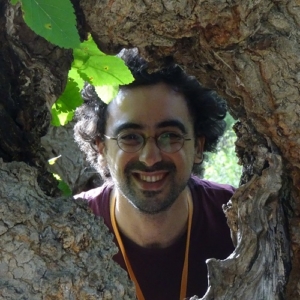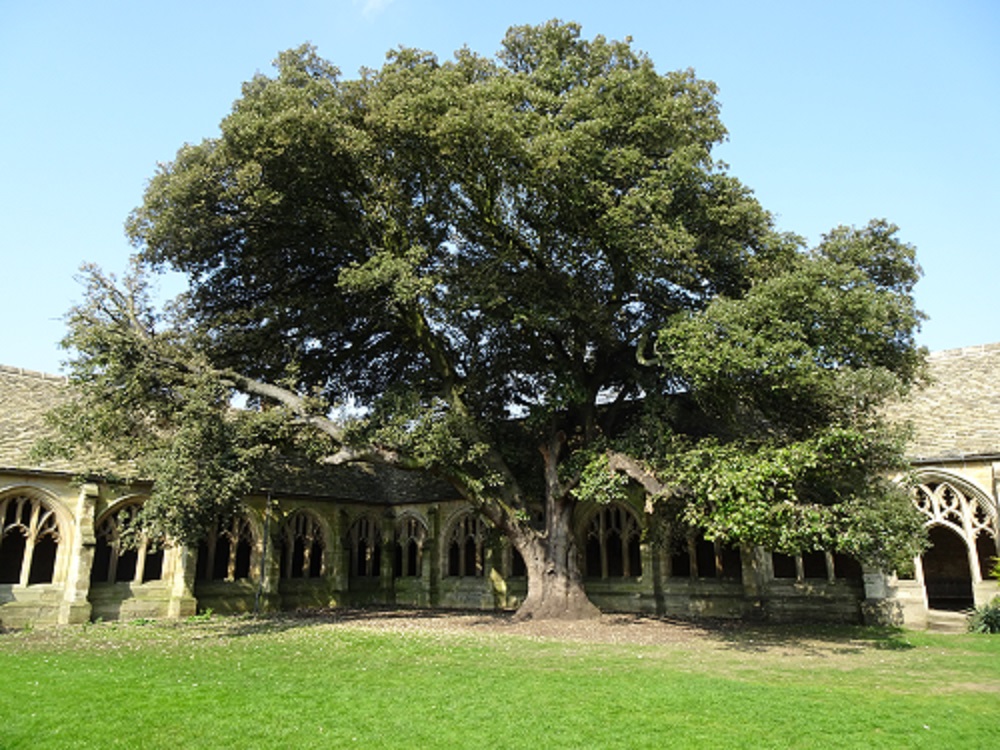 He loved climbing trees when he was a child, but he only discovered much later that he also loved studying them. He recently co-authored a paper – “Tropical tree mortality has increased with rising atmospheric water stress “ – which was published by Nature and widely covered in the media. In this interview, David Bauman (Oxford School of Geography and the Environment/AMAP lab, Montpellier) retraces the history of its passion for plant ecology and explains how a Wiener-Anspach postdoctoral fellowship in Oxford influenced his research and career.
He loved climbing trees when he was a child, but he only discovered much later that he also loved studying them. He recently co-authored a paper – “Tropical tree mortality has increased with rising atmospheric water stress “ – which was published by Nature and widely covered in the media. In this interview, David Bauman (Oxford School of Geography and the Environment/AMAP lab, Montpellier) retraces the history of its passion for plant ecology and explains how a Wiener-Anspach postdoctoral fellowship in Oxford influenced his research and career.
When did you first become interested in biology, more specifically in plant ecology?
It was a very nonlinear path, because I don’t come from a scientific background at all. But I’ve always enjoyed being in nature, seeing trees and climbing them. When I finished school, I went traveling for a year in South America (mostly Brazil and Bolivia), where I participated in a project for wildlife rehabilitation, working with capuchin monkeys. I really enjoyed the work, which included some behavior observation. After that year I wasn’t sure what I wanted to do, but I thought biology could be something interesting, so that I could keep working on wild animal behaviors. I tried biology at the Université libre de Bruxelles, and I really enjoyed it. But then in my second year I had a botany course, something absolutely new for me, and I found that really fascinating. And in my third year I had general ecology, which I thought was really fantastic. A whole new world opened up to me. My interest in ecology, and most specifically in plant ecology, only grew from there on. I did a master’s thesis at the Laboratoire d’Écologie végétale et Biogéochimie, with Thomas Drouet. It was a wonderful experience, and I stayed to do a PhD there.
In 2018, following your PhD you were granted a postdoctoral Wiener-Anspach fellowship to go to Oxford. How did you find out about this opportunity?
It was during my last thesis committee. Someone asked what I wanted to do after that, and I wasn’t too sure. I was interested in doing a postdoc because I enjoyed research enough to want to continue this path. Someone mentioned a foundation that allowed doing a postdoc of one year, either in Oxford or Cambridge. I had a look, and that’s how I contacted Professor Yadvinder Malhi in Oxford. I sent him a CV, told him what my interests were and what I could propose. We had a Skype meeting, I drafted the project, and then I went there to meet him. In the end I stayed a year and nine months in Oxford, because I was granted an extension.
What were your first impressions of that new academic context?
It was very different, and I must say I felt very impressed and a little out of place. I suffered quite a bit of impostor syndrome for a while. But I also enjoyed the opportunity a lot. It was such a dynamic and intellectually stimulating environment. There were so many conferences and prominent guests, people whose papers I read, and who were suddenly there, presenting something and then going for drinks. So it was also a huge opportunity for me to network. Actually, in July 2019, I went to Madagascar for the annual conference of the Association for tropical biology and conservation. And that’s where Yadvinder, my supervisor in Oxford, introduced me to Sean McMahon, who would become my postdoc supervisor at the Smithsonian Environmental Research Center the following year. Another person I also met there is Claire Fortunel, with whom I’m doing my postdoc now in Montpellier, in the AMAP lab (botAnique et Modélisation de l’Architecture des Plantes et des végétations), in collaboration with Yadvinder and Oxford.
Can you briefly present the research you carried out while in Oxford?
Plant ecology in general is about interaction between plants and their environment, both abiotic and biotic (so that means physical, chemical, but also living environment). While in Oxford I became more interested in the temporal aspects of forest ecosystems, and this led me to focus mostly on tree demography. I began to look at tree growth and survival over time, how it varied from species to species, and I focused on tropical ecosystems, which are very species-rich. In Oxford I worked on a network of 24 one-hectare areas of forests that were studied and monitored for 50 years in the northeast of Australia. These are tropical moist forests, so they’re very dense, have a lot of strata, quite high. I studied over 500 species there, how they grew, whether climate change affected their growth, and whether we could predict why some species were more affected than others based on some of their physical – anatomical, morphological, or physiological – characteristics, related to the leaves or to the woods.
So you didn’t have to go to Australia because your research was based on data that had already been collected?
Well, I would have loved to go, but it’s hard to do field work in my case, mostly because trees intrinsically live for hundreds of years, grow extremely slowly, and survive most of the time, otherwise they wouldn’t get so old and big. It’s really hard to obtain enough data to be able to address interesting questions about something which is inherently so slow. I had to rely on very long-term existing data, which are so valuable mostly in the tropics, where they are rarer than in temperate areas. But I really hope to be able to collect data myself in the future, to contribute to the community not only through models and codes, but also through data.
How much math do you need in your field of research?
Statistical modeling is one of the paths you generally have to take if you want to look at something so complex. Ecological data are basically a huge mess. Imagine that you were measuring something that has gone through hundreds of different filters, interactions, at different times. You arrive at some point, and start measuring something which in itself bears the legacy of all these interactions: other trees, climates, tree gaps, winds, disturbances, pathogens, crown damage, soil fertility – there are so many things! Ecology is so complicated precisely because it is fundamentally so connected at different levels, and you have to disentangle these different influences to go back and understand what makes things the way they are, why some trees systematically grow, and grow slower or faster. Even within the same species, what are the differences? What did they experience that made them behave so differently, and why did some survive while others died? It’s a real detective work. And the best toolbox that you have as an ecologist is, first of all, your science and knowing your system, but then you can’t figure out what happened just by looking at the numbers. You need models to test hypothesis and potential alternative scenarios. Another approach is to not begin with the actual data you have, but to simulate something from zero by writing a code. Then you can generate a virtual forest, let’s say, for a certain period of time, and try and see whether you’re playing something that looks like some features that you have observed in nature. These are complementary approaches, but the work I did was mostly based on statistical models.

New College, Oxford (picture by David Bauman).
How did your research evolve after you fellowship period in Oxford?
I was lucky enough to get funding for projects that I had written with colleagues, which allowed for a certain continuity in what I do. As I was saying, I’m really interested in forest demography, individual tree growth and survival, and understanding their drivers. And when I say their drivers, I mean both intrinsically and extrinsically. Intrinsic drivers would be simply a tree size, its age and other characteristics which are inherent to the individual, regardless of the environment. Extrinsic drivers are soil, climate, how dense the neighborhood of the tree is in terms of other trees, etc. With Sean, we tried to better understand how climate can affect survival over long periods of time. More technically, we also worked on developing better models to model survival and therefore better understand it.
How do you define survival?
That’s a good question. We know that, by definition, most trees survive a lot, because they take a very long time to grow and to even be able to begin to reproduce. So for forests to exist, you need very long living organisms that have a high probability of surviving – and not dying – every year. Some people are interested in physiological detailed mechanisms that allow trees to withstand disturbances of pathogens, so they focus on what happens inside the tree. We are more interested in the ecological point of view. We know that some major mortality risk factors for trees are climatic stress such as drought, or repeated and extreme drought, or wind storms. So crown damage caused by the wind, for example, or by another tree falling, increases the probability of dying of something else later (pests and pathogens, lightning..). We now understand more and more that trees generally don’t die just because of one reason, but because of interacting multiple reasons that affect the individual potentially at different times, which is why it’s so difficult to predict which trees are more likely to die at some point. But then, again, it’s sort of detective work – trying to figure out what happened, and trying to figure it out in a way that has some generalizability to it. You want to find a balance between explaining the system that you are studying and taking something back that can generalize to some extent to other systems alike.
Your research is closely related to one of today’s hottest topics, the impact of climate change.
Well, it is related whether I want it or not, because if I have to use data that goes back ten, twenty, thirty years back (when you’re lucky even more than thirty, like with the Australian data), you have to deal with the fact that during this time, one of the prominent influences was that climate was changing very fast. The average temperature was rising, and because of that, the atmospheric water stress was also rising. So this relates to the evaporative demand, that is, how much the lack of humidity in the air, with respect to what it can contain, sort of pulls the water out of the leaves. This creates a hydric stress for plants in general, which is one of the serious reasons why some places have experienced increased mortality in trees or other plants.
So whether you want it or not, it is one of the influences you have to take into account. And of course, I think there’s a basic science side to it, which is trying to understand what affects trees in how they grow, survive and reproduce. Do some species take over other species because they have better adaptations for those sorts of stresses or new conditions? And then of course there’s the crucial role that forests play in mitigating climate change, too. We know that to grow, trees need to photosynthesize, and by photosynthesizing they absorb CO2 and store it for a long period of time in their trunk and long living tissues. So they actually decrease the amount of greenhouse gases in the atmosphere, which is good, because every year they reabsorb a significant amount of the greenhouse emissions that we are responsible for. Trees can’t save us from climate change on their own, but they’re a very important buffer. The thing is that the future of this buffer is uncertain, because when trees die, they are decomposed by fungi, bacteria, etc, and they turn into CO2 that goes back in the atmosphere. So this is a dynamic system, where you have CO2 entering the forests, and CO2 going out of the forests. And if growth decreases or does not change while mortality increases, tropical forests may stop being carbon sinks – these moderate breaks on human-induced climate change – and become net carbon sources, releasing more carbon into the atmosphere than they absorb. This, unfortunately, is what we show is happening in the tropical moist forests of Australia, and likely in other regions of the tropics, in our recent Nature paper showing a marked increase in tree mortality in these forests, as a result of climate change. This finding further stresses the urgency of rapidly cutting greenhouse gas emissions while transitioning massively to renewables and a more sustainable society.
One last question about photography: you’ve shared with us some beautiful pictures of trees and flowers, and I was wondering if this passion for nature photography goes back a long way?
I just enjoy taking pictures of plants or landscape, but I don’t have a very professional material. It helps me seeing things and it’s relaxing. Actually, I bought my first camera when I first became interested in botany. And the only objective was to take pictures of plants and flowers so that I could identify them, make folders and remember them. It’s a sort of virtual herbarium, and it’s something I still do, from time to time.
Links
“Tropical tree mortality has increased with rising atmospheric water stress“, Nature (2022)
“Rainforest trees may have been dying faster since the 1980s because of climate change – study”, Oxford News (18 May 2022)
“Tropical tree growth sensitivity to climate is driven by species intrinsic growth rate and leaf traits”, Global Change Biology (2021)
Follow David on Twitter: @davbauman


